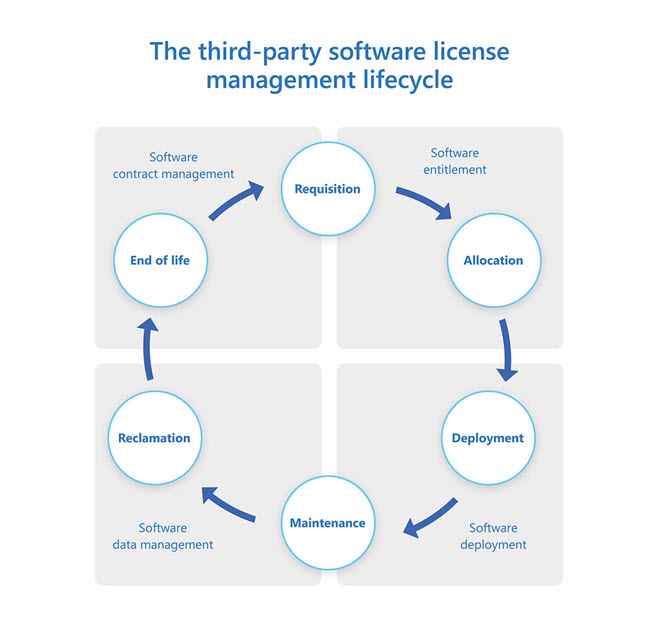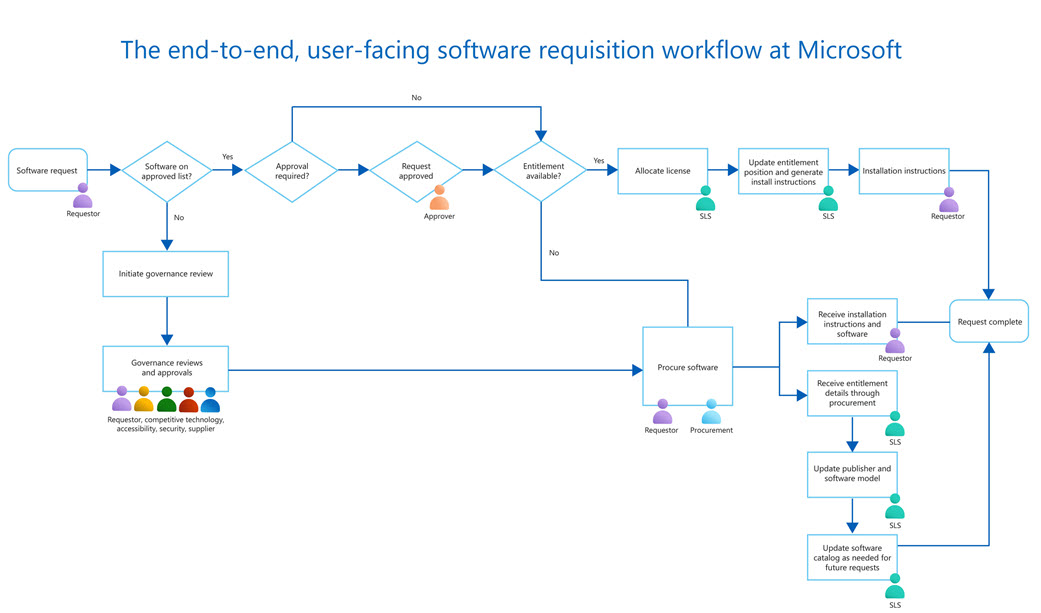 In an organization the size of Microsoft, employees need a wide array of tools to accomplish their work. For many, third-party software is part of their toolbox, and that means we need to purchase, organize, and manage software licenses on a massive scale. Robust software asset management is essential for making sure the process is efficient for employees, optimized for license managers, and meets rigorous compliance standards.
In an organization the size of Microsoft, employees need a wide array of tools to accomplish their work. For many, third-party software is part of their toolbox, and that means we need to purchase, organize, and manage software licenses on a massive scale. Robust software asset management is essential for making sure the process is efficient for employees, optimized for license managers, and meets rigorous compliance standards.
Our Software Licensing Service (SLS) is the Microsoft Digital Employee Experience team responsible for software asset management.
“When you think about software asset management, you want to track a license’s lifecycle from requisition through allocation and deployment,” says Patrick Graff, the senior service engineer leading the SLS team. “Then you need to maintain it until you can reclaim it at the end-of-life stage.”

If individual departments and employees manage their own software licenses, organizations are open to all kinds of inefficiencies and risks—not to mention a subpar experience for employees who need access to third-party software. Manually tracking the number of licenses enterprise-wide, total spend, and overall software entitlements is incredibly labor-intensive.
Under those fragmented circumstances, how can a procurement department know the total entitlements from a particular vendor? How do they ensure their company maintains the proper enterprise licensing position at scale? Do they know how many unallocated licenses are available? And how do they manage reclamation, reallocation, and rightsizing during renewal and true-up cycles?
SLS wanted an enterprise-level platform that would both streamline the employee experience and optimize license management. So they partnered with Microsoft Procurement and Infrastructure Engineering Services (IES) to implement a unified software catalog.
[Learn about streamlining vendor assessment with ServiceNow VRM at Microsoft. See how Microsoft is Modernizing the support experience with ServiceNow. Read about instrumenting ServiceNow with Azure Monitor.]
A strategic partnership drives software licensing excellence
Since 2015, we’ve used ServiceNow to automate our helpdesk support process. When they introduced their Software Asset Management (SAM) module, it was a natural fit for implementing a centralized software catalog.
“The scope of work and the objective resonated with SLS because they understood the pain points of using disconnected tools,” says Sherif Mazhar, principal product manager for the IES team partnered with SLS. “They were interested in consolidating those tools and gaining the ability to track license usage accurately.”
We started seeing better control, better insights, better reporting, and also better visibility into unused licenses and how we could reassign them.
—Sherif Mazhar, principal product manager, Infrastructure Engineering Services
Thanks to collaboration with ServiceNow engineering teams, ServiceNow features well-tuned, out-of-the-box compatibility with Microsoft technologies. They also maintain an enterprise roadmap to streamline large integrations.
The teams started small with a single license portfolio: Adobe Creative Cloud. Tools like Adobe Photoshop and Premiere Pro are essential for creatives, but many groups had purchased their own licenses on an ad-hoc basis.
Once the Adobe licenses were consolidated into ServiceNow SAM, the team saw rapid results. “The value realization was quick with Adobe,” Mazhar says. “We started seeing better control, better insights, better reporting, and also better visibility into unused licenses and how we could reassign them.”
Within 12 months, the team had cut back excess licenses across Microsoft, resulting in significant savings. With such a successful pilot already showing results, SLS decided to move forward with a more universal ServiceNow SAM implementation.
Implementing ServiceNow Software Asset Management across Microsoft
ServiceNow features several out-of-the box enterprise integrations, but the work of developing one process for license management required extensive collaboration between SLS and IES.
Several different technologies needed to come together to facilitate a unified experience:
- Microsoft System Center Configuration Manager (SCCM) connectors provide one-directional imports into ServiceNow, bringing relevant data into the ServiceNow instance from an SQL Server database and mapping it to ServiceNow’s SAM database.
- Microsoft SharePoint grants automatically provisioned access to relevant download files once the software is allocated to the end user.
- Microsoft Azure Active Directory (AAD) handles identity and access management for software acquisition, enabling single-sign-on (SSO) and multi-factor authentication (MFA) capabilities for cloud-based and SaaS tools.
- A Microsoft Teams integration for the ServiceNow Virtual Agent helps employees troubleshoot and seek support via chat within a Teams App.
Once the ServiceNow implementation was complete, the team needed to loop the whole project into the existing employee workflow by connecting it with internal procurement and IT portals. SLS ensured that employees felt at home in the new experience by unifying the catalog’s color coding and UI with the portals employees already know how to navigate.
The result is a streamlined experience for employees and a management environment that delivers optimization and compliance.

A transformative third-party software licensing experience
When one of our employees wants access to third-party software, they log in to the IT or procurement portal of their choice and navigate to the Unified Software Catalog in ServiceNow. From there, they simply find the software tool they need and submit a request.
If a piece of software requires no extra permissions, the employee can simply requisition it. Otherwise, they fill out a request form, which initiates an automated workflow that manages permissions, their device’s operating system, relevant purchase orders and cost centers, and our entitlements within that software portfolio.
The real power of the tool is that we can set up configurable workflows for different types of products.
—Tony Bouker, senior product manager, Infrastructure Engineering Services
When the license allocation is complete, the end user gets an email with installation instructions. They can then proceed to an automatically provisioned SharePoint folder to download and install the software.
For SaaS tools and cloud-based suites like Adobe Creative Cloud, the team has created another way to access their software. The system adds the employee’s alias to an internal identity group, which grants access through SSO powered by AAD.
“The real power of the tool is that we can set up configurable workflows for different types of products,” says Tony Bouker, senior product manager with IES.

Efficiency, optimization, and compliance
Microsoft SLS has integrated the software requisitioning process into the Bing search engine. Now, employees can search software titles through Bing, which then points to the Unified Software Catalog.
Employees no longer have to conduct manual, online searches for third-party software or send emails asking for requisitions. Now they simply search in Bing or head directly into the Unfied Software Catalog and initiate an automated requisition workflow.
For SLS, the outcomes are about data-driven insights and license consolidation. The team can track Microsoft’s overall licensing position across all third-party software without the need for time-consuming detective work or manual uploads. When the time comes for renewals and true-ups, that visibility is essential.
It also mitigates risk through robust governance and policy by reducing vulnerabilities, data breaches, and license compliance violations.
On a more strategic level, the tool helps SLS optimize our software licensing frameworks for individual providers. For example, if one employee uses several tools within a provider’s toolkit, the team has the data it needs to decide whether it’s more efficient to allocate those licenses individually or as part of an “all-apps” subscription.
On the macro level, it gives us the ability to negotiate volume licenses more accurately, at exactly the level that fulfils our organizational needs. Good data drives informed decision making.
As those optimizations scale, Graff estimates that we’re saving an average of 10 percent across all of our enterprise license positions. For an organization the size of Microsoft, that represents cost savings in the millions.
Beyond Microsoft, this implementation is laying the groundwork for a wide-ranging change in how enterprises manage their third-party software. “If you look at the Microsoft presence in the market, every single customer who’s using our technologies leverages our endpoint management tools for asset management and license tracking,” Mazhar says. “So this will open the door for a lot of opportunity for Microsoft, for ServiceNow, and for our customers.”

- Start small with a targeted publisher and gain early wins to build confidence with stakeholders.
- Have a close relationship with your partner teams so you can recognize needs and grab opportunities.
- Build out your key process areas first, and identify workflow patterns you can reuse to scale your software asset management program.
- Establish policies to make sure the changes you put into effect have teeth.
- When working with a third-party partner, make sure you have the right connections to ensure you can provide feedback at the right level.
- Ensure leadership understands your priorities so they can manage those relationships at the highest level.







